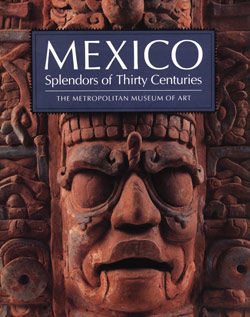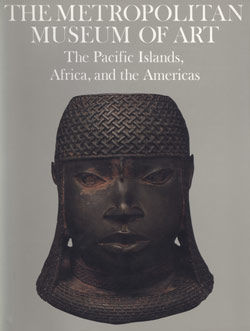Standing Figure
Not on view
A sculptor created this standing figure, whose legs were broken intentionally in antiquity, from a dense green schist. The figure stoically gazes forward with arms at its side. The disproportionately large head displays conventionalized features: a squared off head and ears, arching brows, and slightly protruding, partially open mouth. The ear holes, eyes, and mouth likely once held ornaments or inlays of shell, pyrite, or another precious material. Further drill holes under the ears may have been used to attach perishable materials such as clothing or a ceremonial bundle. Subtle, fluid incisions and raised areas indicate the rib cage, bend of the arm, wrist bones, and fingers. The surface is finely polished.
Standing figures of this scale and three-dimensional form are exceedingly rare in the corpus of Teotihuacan sculpture, with only about a dozen known examples. Similar sculptures excavated at the city center indicate that these types of works were used in private rituals in interior shrines, or created specifically for dedicatory or sacrificial offerings to be buried in pyramids or tunnels. The intentional nudity of the sculpture could refer to these sculptures as proxy war captives ready for sacrifice, with the violent removal of the sculptures’ legs as a final act of termination.
Further reading
Berrin, Kathleen, and Esther Pasztory. Teotihuacan: Art from the City of the Gods. The Fine Arts Museums of San Francisco, 1993.
Carballo, David M., Kenneth G. Hirth, and Barbara Arroyo. Teotihuacan: The World Beyond the City. Dumbarton Oaks, 2020.
Cowgill, George L. State and Society at Teotihuacan. Annual Review of Anthropology, Vol. 26, pp. 129-161, 1997.
Headrick, Annabeth. The Teotihuacan Trinity: The Sociopolitical Structure of an Ancient Mesoamerican City. University of Texas Press, 2007.
López Luján, Leonardo, Laura Filloy Nadal, Barbara W. Fash, William L. Fash, and Pilar Hernández. The Destruction of Images in Teotihuacan: Anthropomorphic Sculpture, Elite Cults, and the End of a Civilization. RES: Anthropology and Aesthetics, no. 49/50, pp. 12-39, Spring-Autumn, 2006.
Manzanilla, Linda R. Cooperation and tensions in multiethnic corporate societies using Teotihuacan, Central Mexico, as a case study. Proceedings of the National Academy of Sciences of the United States of America, Vol. 112, No. 30, pp. 9210-9215, 2015.
The Metropolitan Museum of Art. Art of Oceania, Africa, and the Americas from the Museum of Primitive Art. New York: The Metropolitan Museum of Art, 1969, no. 574.
Museum of Primitive Art. Masterpieces in the Museum of Primitive Art: Africa, Oceania, North America, Mexico, Central to South America, Peru. Handbook series. New York, NY: Museum of Primitive Art, 1965, no. 85.
Newton, Douglas. Masterpieces of Primitive Art: The Nelson A. Rockefeller Collection. New York: Alfred A. Knopf, 1978, p. 120, lower right.
Newton, Douglas, Julie Jones, and Kate Ezra. The Pacific Islands, Africa, and the Americas: The Metropolitan Museum of Art. New York: The Metropolitan Museum of Art, 1987.
Pasztory, Esther. Teotihuacan: An Experiment in Living. University of Oklahoma Press, 1997.
Paz, Octavio. Mexico: Splendors of Thirty Centuries. New York: The Metropolitan Museum of Art, 1990.
Robb, Matthew. Teotihuacan: City of Water, City of Fire. Berkeley: University of California Press, 2017.
Ruiz Gallut, María Elena, and Jesús Torres Peralta, eds. Arquitectura y urbanismo: pasado y presente de los espacios en Teotihuacan: Memoria de la Tercera Mesa Redonda de Teotihuacan. Mexico City, Instituto Nacional de Antropología e Historia, 2005.
Sarro, Patricia J., and Matthew H. Robb. Passing through the Center: The Architectural and Social Contexts of Teotihuacan Painting. In Cynthia Kristan-Graham and Laura M. Amrhein, eds., Memory Traces: Analyzing Sacred Space at Five Mesoamerican Sites, pp. 21-43. University Press of Colorado, 2015.
Sugiyama, Saburo. Human Sacrifice, Militarism, and Rulership: Materialization of State Ideology at the Feathered Serpent Pyramid, Teotihuacan. Cambridge University Press, 2005.
Due to rights restrictions, this image cannot be enlarged, viewed at full screen, or downloaded.
This artwork is meant to be viewed from right to left. Scroll left to view more.







